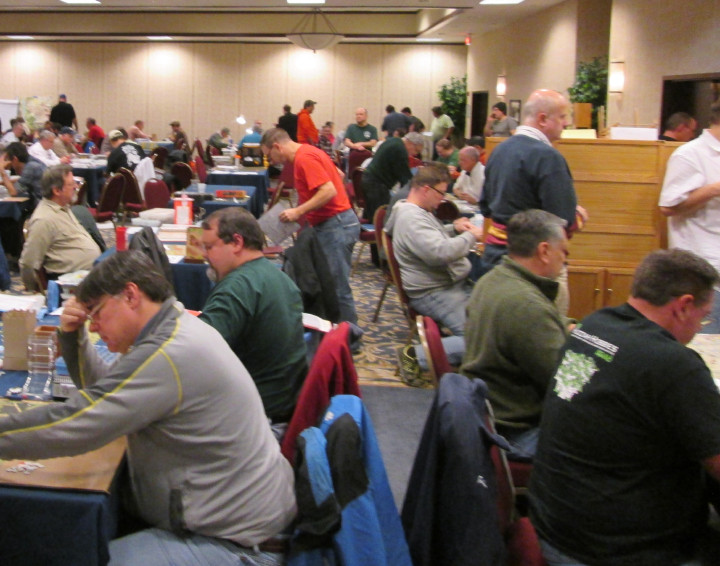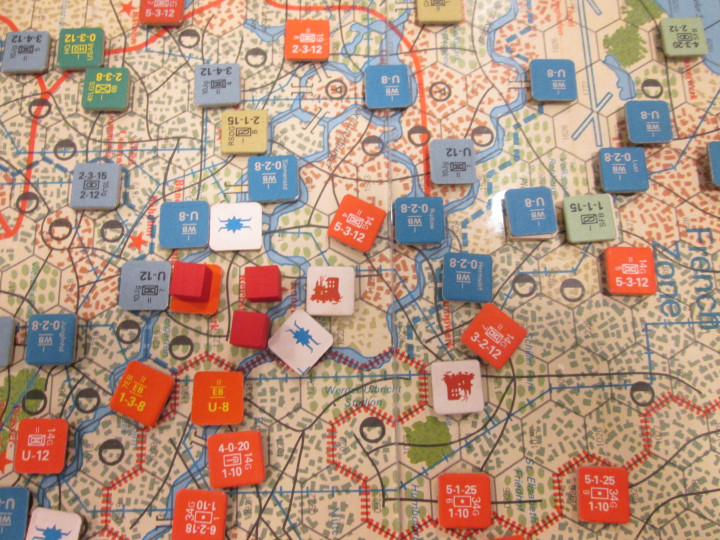If awards were given out for truth in advertising, then Winter Offensive 2016 would win handily. This year’s edition of the East Coast’s premier Advanced Squad Leader tournament coincided with the largest snowstorm in quite some time. As of this posting, it’s still going on, as I abandoned not-so-bucolic Bowie, Maryland, on Friday the 22nd, opting not to ride out the storm at the Comfort Inn Conference Center. More than a few hearty souls have decided to hunker down, though, obviously tempted by the prospect of being snowed in with nothing to do but play games until the roads clear. Certainly seems like one version of paradise, I have to confess.
By the time I left, about three hours before the onset of the snow, at least sixty people were still rolling dice and pushing cardboard. Over a hundred people were reported to have pre-registered, and more gamers showed up on the con’s initial day, Thursday, than I recall in recent memory. The usual crowd turned out in full force, with the crews from North Carolina, New York, and Norfolk all well in attendance in addition to the local lads. Still, despite the decent showing, Winter Offensive felt smaller this year, solely because the sliding wall partitions between the three convention rooms remained closed for unclear reasons. Also unexpected, MMP gave pre-registered attendees a gratis copy of ASL Journal 11, crammed full of new scenarios, including a pair of three-player scenarios sure to see much play.
So, with only twenty-four hours to play, I tried to cram in as much gaming as possible. Starting off on Thursday afternoon, I matched wits with all-around good guy Mike Vogt in BoF8 “Sting of the Italian Hornet,” an Advanced Squad Leader scenario full of funky Italian vehicles. (I sort of have a weakness for funky Italian vehicles.) We had pre-arranged the match, so I spent a fair bit of time before the con sketching out my Italian defense, putting my infantry guns up front and hoping to keep them hidden until Mike’s Canadians rolled their vehicles by, so I could try for flank and rear shots. Of course, Mike made an unerring beeline right for the gun positions, and both were quickly surrounded by infantry and tanks. I got some lucky shots and landed a few big hits, managing to keep the Canadians at bay long enough to stymie Mike’s carefully plotted advance. He moved as quickly as possible through the protective smoke he artfully laid down, but time was against him.

A solid scenario (if a bit tight for the Canadians in terms of their goals) against a great opponent. Definitely the kind of scenario that reminds you why ASL has been around as long as it has—lots of moving parts that fit together very well to produce an entertaining (if not entirely historically accurate) gaming experience.
Thursday evening, Mike and I joined John Slotwinski, Doug Bush, and Ken Dunn for the traditional Winter Offensive match of Battlestar Galactica. Many, many Basestars were used in the early going, with four on the map at once, accompanied by the entire piece mix of Cylon Raiders. Sadly (for me, as a Cylon), the Galactica and Pegasus escaped from that trap using Cain’s emergency jump one-time ability, and the humans had a fairly easy coast to victory thereafter. In my mechanical defense, I didn’t become a Cylon until after the great escape, so I might have been inadvertently instrumental in helping the humans win just a little bit. Not that anyone cared, because the first action taken after the narrow escape was to put me in the Brig. Hmph. A fine session with some thoroughly enjoyable gamers. As should always be the case after a good game of Battlestar Galactica, the recriminations will last for months.

Friday, Doug and I set up Mikugames’ Tornio ’44, a company-level game on the Finnish naval landings behind German lines in central and western Finland, designed to trap the evacuating Germans after the Finnish/Soviet armistice. The game uses an interesting combat system, where the final odds ratio of a combat corresponds directly to the number of dice rolled; the opposing player must spend that dice roll total via a menu, from an inexpensive and relatively mild Broken status through retreats and step losses. The situation itself offers a fascinating challenge, as the Germans have to face Finnish units arriving from several avenues (most of which are chosen by the Finnish player) while keeping escape routes open and protecting victory point locations. The gameplay ebbs and flows. My Finns opened strongly, then the weather turned poor, delaying my reinforcements by a turn and allowing Doug’s Germans to occupy one of my planned avenues of advance. I was able to recover somewhat, but the density of German artillery began to take a toll on my units. We had to call the match half-way through due to the onset of snow (in the real world, not the game) with the Germans arguably in better shape, VP-wise. Hopefully we’ll be able to get this one on the table again for a full session, because it’s the most interesting wargame I’ve played in some time.

As always, my congratulations and thanks to the team at Multi-Man Publishing for another solid event, albeit one that was cut somewhat short for me. It felt strange, and somewhat wrong, to be leaving on Friday as opposed to Sunday, but since I used up quite a bit of my luck via gaming, I didn’t want to take chances with Mother Nature this time out. I hope everyone still there has a safe and enjoyable time of it.






 I managed to game aplenty, though. After spending much of Thursday catching up with people, I spent the vast majority of Friday playing a huge scenario from GMT’s
I managed to game aplenty, though. After spending much of Thursday catching up with people, I spent the vast majority of Friday playing a huge scenario from GMT’s 
